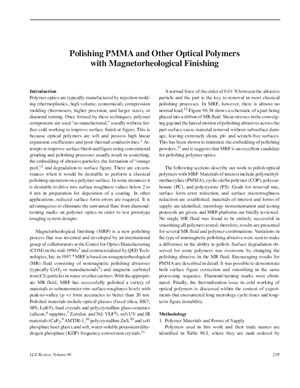Статья. Опубликована в журнале "LLE Review". – 2003. – Vol. 96 – P.
239-249.
Название на русском языке: Магнитореологическое полирование
полиметилметакрилата и других оптических полимеров.
Авторы: J. DeGroote, H. J. Romanofsky, I. A. Kozhinova, J. M.
Schoen, S. D. Jacobs.
Аннотация к статье на английском языке:
Experiments were conducted with conventional and experimental MR fluids to polish four optical polymers. A ZrO2- based MR fluid was successfully used on a Q22Y MRF machine to smooth and figure correct the plano surface of a diamond-tued PMMA part to 0.5 nm rms and 0.4 mm p v, respectively. The diamond-tuing marks were eliminated. Of the other abrasive/polymer combinations tested, Al2O3 showed the greatest potential for processing COP, PS, and PC without roughening or introducing surface artifacts. Issues of part thermalization for metrology were encountered. It was found that 90 min were required to stabilize the surface figure of an 8-mm-thick PMMA puck between runs and at the conclusion of a polishing experiment. Long-term surface figure instabilities were also observed for a PMMA puck after cold working both sides of the part.
Experiments were conducted with conventional and experimental MR fluids to polish four optical polymers. A ZrO2- based MR fluid was successfully used on a Q22Y MRF machine to smooth and figure correct the plano surface of a diamond-tued PMMA part to 0.5 nm rms and 0.4 mm p v, respectively. The diamond-tuing marks were eliminated. Of the other abrasive/polymer combinations tested, Al2O3 showed the greatest potential for processing COP, PS, and PC without roughening or introducing surface artifacts. Issues of part thermalization for metrology were encountered. It was found that 90 min were required to stabilize the surface figure of an 8-mm-thick PMMA puck between runs and at the conclusion of a polishing experiment. Long-term surface figure instabilities were also observed for a PMMA puck after cold working both sides of the part.

